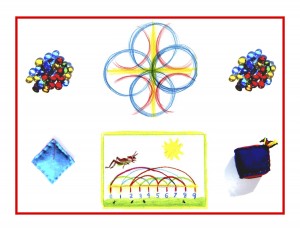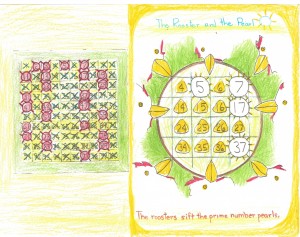Day 156
For one year, 365 days, this blog will address the Common Core Standards from the perspective of creating an alternate, ambient learning environment for math. Ambient is defined as “existing or present on all sides, an all-encompassing atmosphere.” And ambient music is defined as: “Quiet and relaxing with melodies that repeat many times.
Why ambient? A math teaching style that’s whole and all encompassing, with themes that repeat many times through the years, is most likely to be effective and successful. Knowledge ensues in an environment dedicated to imaginative, creative knowing, where student and teacher alike surrender to the ensuing of knowledge as a worthy goal. Tune in tomorrow to continue with the Common Core ELA standards and their ambient counterparts. Today’s post will feature the fable “The Rooster and the Pearl” and how it can be related to the prime numbers. See below for the suggested drawing, and here’s the story:
A Rooster was once strutting up and down the farmyard among the hens when suddenly he spied something shining amid the straw. “Ho! ho!” said he, “that’s for me,” and soon rooted it out from beneath the straw. What did it turn out to be but a Pearl that by some chance had been lost in the yard? “You may be a treasure,” said Master Rooster, “to men that prize you, but for me I would rather have a single barley-corn than a peck of pearls.”
Precious things are for those who can prize them.
The prime numbers are divisible only by one and themselves. But, like the Pearl, the prime numbers are not as useful or practical as composite numbers. Because composites are factorable they, like the barley-corn, are commonplace, but more helpful. Primes can be sorted out from composite numbers by putting them through a “sieve” as the pearls might be sifted out from the corn. The Greek mathematician Eratosthenes invented a sieve to sift the prime numbers in the 2nd century BCE. This correlation is for you, the teacher. If you choose to share any of these facts, it needs to be done in a pictorial way. It may be enough to tell the story, have your child(ren) retell it the next day, then proceed to the activity and the drawing. To introduce this version of the prime numbers sieve say, “Let’s sift out the Pearls so the Rooster and Hens can eat!”
First you will need a square piece of paper. Here’s how to fold it into 100 squares (do have your child(ren) help with this!):
Start with a square piece of paper, at least 8 1/2″ (preferably plain white)
Fold it in half twice so you have four columns
Fold this in thirds (like a letter fold) so you now have 12 columns
Open the paper up and do the same folds the other way
You now have 144 boxes
Cut off or color the outside rows on all four sides
You now have 100 boxes.
Go over all the creases with a yellow pencil to outline the boxes.
Write the numbers 1-100 with a #2 pencil in each square. Then sift the primes! Cross out the non-prime numbers with one color, and circle the primes with another.
Cross 1 out/it’s not a prime
Circle 2/the only even prime
Cross out every 2nd number
Circle 3
Cross out every 3rd number/some may already be
Circle 5
Cross out every 5th number
Continue until all numbers are circled or crossed out.
ALL primes end in 1, 3, 7, 9 (except 2 and 5)!!
And here’s how to teach the drawing (the Rooster section only):
Draw a large circle in the middle of the paper
Divide it with 5 vertical and horizontal gridlines
You now have 16 squares (this is the Roosters’ sieve)
Take any 4×4 section of the primes chart
Copy it into the grid
The prime numbers should be larger and circled
Lightly color them in, with sparkles
Composite numbers are smaller, as the yellow barley-corn kernels.
Color the yellow rooster beaks all around!













